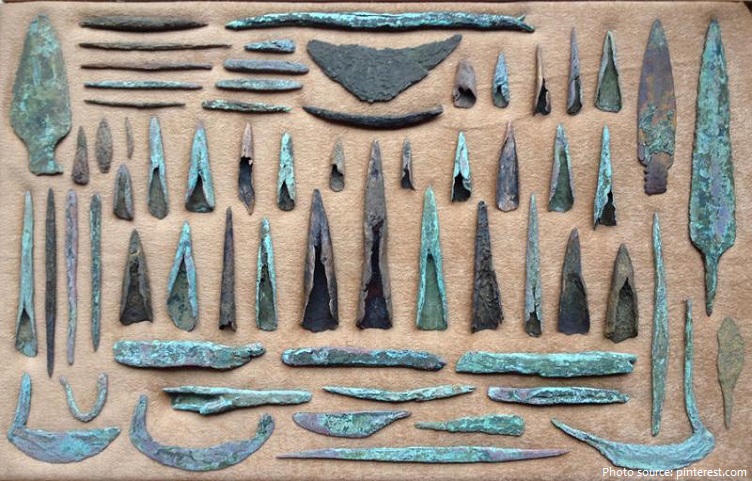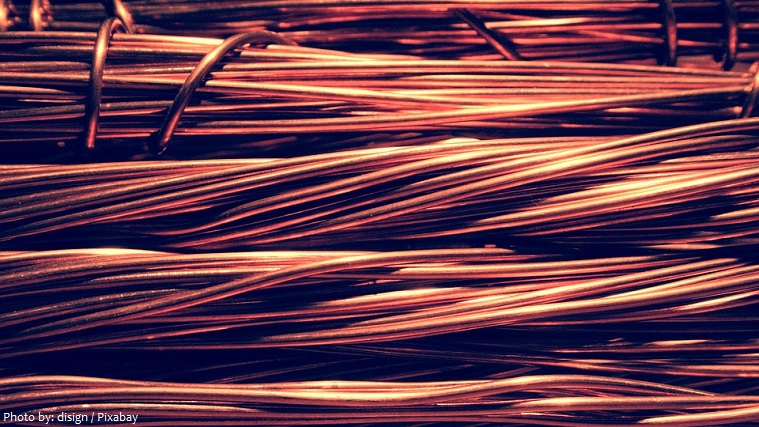Copper is a chemical element with the symbol Cu and atomic number 29.
Reddish orange in color, it is ductile, malleable, and an excellent conductor of heat and electricity.
Copper is one of the few colored metals. Most metals are gray or silver. Gold, copper, caesium and osmium are the only four colored metals.
It is one of the few metals that can occur in nature in a directly usable metallic form (native metals).
Copper and its alloys are extensively used for electrical wiring and machines, electronic components, structural materials, cooking utensils and flatware, coinage, musical instruments, and sculptures.
It ranks 3rd after iron and aluminum in terms of quantities consumed
Copper resists the action of the atmosphere and seawater. Exposure for long periods to air, however, results in the formation of a thin green protective coating (patina).
It was probably the first metal used by ancient cultures, and the oldest artifacts made with it date to the Neolithic period.
The shiny reddish orange metal was used in the Balkans, Middle East, and Near East from at least 8,000 to about 3,000 BC. Egypt and Europe later followed suit and began to make their own copper artifacts.
Early copper artifacts, first decorative – then utilitarian, were undoubtedly hammered out from “native copper,” pure copper found in conjunction with copper-bearing ores in a few places around the world.
It was the first metal to be smelted. The earliest known smelting site is in Serbia and dates to c. 5000 BC
In the Roman era, copper was principally mined on Cyprus, the origin of the name of the metal, from aes сyprium (metal of Cyprus), later corrupted to сuprum (Latin), whence coper (Old English) and copper, first used around 1530.
Alloying copper with tin to make bronze was first practiced about 4000 years after the discovery of copper smelting, and about 2000 years after “natural bronze” had come into general use. Bronze artifacts from the Vinča culture date to 4500 BC.
There are more than 450 copper alloys , including brasses, bronzes, copper-nickels, nickel-silvers, and other specialty alloys.
Like aluminium, copper is recyclable without any loss of quality, both from raw state and from manufactured products. In volume, copper is the third most recycled metal after iron and aluminium. An estimated 80% of all copper ever mined is still in use today.
Copper is an essential trace element vital to the health of all living organisms. Although the amount of copper found in the human body (50 to 120 milligrams) would fit on the head of a pin.
During the rise in demand for copper for the Age of Electricity, from the 1880s until the Great Depression of the 1930s, the United States produced one third to half the world’s newly mined copper.
The oldest copper artifact is a pendant discovered in what is now northern Iraq has been dated to about 8,700 BC.
The heaviest statue in the world is made from copper. The Statue of Liberty, officially named Liberty Enlightening the World has total weight of 204 metric tonnes (225 US tons). The height of the Statue of Liberty is 46 meters (151 feet) from the base to the torch. The copper statue, designed by Frédéric Auguste Bartholdi, a French sculptor, was built by Gustave Eiffel and dedicated on October 28, 1886. It was a gift of friendship from the people of France to the United States.
The tallest Buddha is made from copper. It is the Zhongyuan Buddha which measures 127.64 m (418 ft 9.19 in) and is situated in Lushan County, Henan Province, China. It was consecrated on 1 September 2009 and was measured on 2 December 2009.
The largest gong is made from copper. It measures 5.15 m (16.8 ft) in diameter and weight 568 kg (1252 lb). The gong was made by Shanxi Baodi Real Estate Development CO. Ltd and displayed at the Third China Taiyuan International Cooked Wheaten Food Festival, Shanxi Province, China on 8 September 2005.
The smallest nano calligraphy is wrote on copper surface. In March 2009, researchers Hari Manoharan and Christopher Moon, of Stanford University, were able to write letters so small that they are composed of subatomic pixels no bigger than 0.3 nanometres. The team ‘wrote’ the letters “S” and “U” for Stanford University using a scanning tunnelling microscope to arrange individual carbon monoxide molecules on a copper surface in a complicated two-dimensional pattern.







